Outdoor LED Lighting Market Trends
Market Driver - Unique Advantages of LED Lights, Including Long Lifespan, Energy Efficiency, And Compactness Compared to Alternatives
LED lights have clearly emerged as the preferred technology for outdoor lighting due to their unparalleled benefits over traditional lighting options such as incandescent bulbs. LEDs offer significantly longer operational lifetimes compared to other lights - while incandescent bulbs may last around 750-1000 hours, LEDs can illuminate areas efficiently for over 50,000 hours which is nearly 20 years of service if used for average 4 hours daily. This translates to huge savings as users don't need to replace lights for many years.
LED lights are also extremely energy efficient - they use at least 75% less energy than traditional lighting to generate the same brightness. This is a major factor driving their adoption considering the rising electricity costs and focus on minimizing carbon footprint. LED lights also run cooler while operating and don't emanate as much heat as other lights. They pose negligible fire risk making them much safer. LED bulbs are more shock resistant and durable due to lack of exposed filaments unlike incandescent bulbs. Outdoor LED lights can withstand shocks, vibrations and harsh weather very well.
Furthermore, LED lights have a compact design and can fit into much smaller fixtures compared to bulbs of other technologies. This allows their use even where space is at a premium. They support a variety of lighting designs through different form factors and can blend well with any landscape or infrastructure. LEDs are available in varied color temperatures from warm yellow light to cool white and even multicolored for enhanced visual appeal. They provide focused, glare-free bright light exactly where needed avoiding wastage. All these technical merits have helped LED lights gain wide popularity worldwide for outdoor residential, commercial and municipal applications.
Market Driver - Increased Demand from Smart City Initiatives
Urban local bodies worldwide are giving a major push for development of smart cities with enhanced digital and physical infrastructure. Smart street lighting networks are foundational for smart cities where lights become “smart nodes” integrated with various technologies. Outdoor LED lights have emerged as the ideal solutions for smart streetlights due to their robust IP/weatherproof ratings and long operational lifetimes. As smart city projects accelerate globally leveraging latest connectivity and cloud solutions, demand is surging for outdoor LED lights configured with intelligent controls, motion sensors and other smart nodes features. To achieve energy and cost saving targets of smart city plans, municipal corporations are actively retrofitting conventional street lights to networked LED variants which can be centrally monitored and managed. IoT enabled LED lights ensure uniform illumination of roads and public places. Sensors allow dimming or turning on/off lights based on detected movement for adaptive functionality. Connected LED lights also support add-on smart city applications like air quality monitoring, property surveillance cameras or evacuation guidance displays. All these advantages have been triggering greenfield smart infrastructure development projects fuelling substantial demand. Multinational LED luminaries are proactively partnering with technology providers to deliver integrated smart lighting systems for smart community initiatives.

Market Challenge - Higher Initial Costs of LED Installations, Limiting Adoption in Small and Medium-Sized Businesses
One of the key challenges faced by the outdoor LED lighting market is the higher initial costs associated with LED installations as compared to traditional lighting sources such as high-pressure sodium (HPS) lamps. While LED lights offer significant energy savings over the lifespan of the product owing to their long operating hours and high efficiency, the upfront capital required for full conversion to LED solutions poses a barrier, especially for small and medium-sized commercial clients and municipalities working on constrained budgets. LED fixtures are generally 3-4 times more expensive than traditional lamps, translating to thousands of extra dollars that may not be available for lighting upgrades. Additionally, the payback period from energy cost savings can stretch from 3-7 years depending on usage patterns. This extended time period before positive cash flows are seen discourages many potential customers who seek quicker returns on investment. LED installation services and components also have higher pricing in several markets due to lack of scale and competition. Addressing the high initial costs, through innovative financing solutions, subsidies, and bulk purchase programs can help spur greater LED deployment among SMBs.
Market Opportunity: Technological Advancements in LEDs, Such as Perovskite Light-Emitting Diodes (PeLEDs), Enhancing Efficiency and Brightness
One of the major opportunities for the outdoor LED lighting market is the ongoing technological innovations that are improving the capabilities and driving down the costs of LED solutions. An emerging area is perovskite light-emitting diodes or PeLEDs which promise to significantly boost both the efficiency and brightness levels of LED lights. Perovskites possess properties that allow for inexpensive fabrication techniques as well as high luminous efficiencies that surpass existing LED technologies. Successful commercialization of PeLEDs could usher in a new generation of LED lights that deliver more lumens per watt while being cheaper to produce. Other current advancements include enhanced light extraction from tiny micro-LED chips and the development of red and yellow LEDs with improved performance. As the underlying LED technology matures further with continuous R&D, the cost factors holding back demand particularly in price-sensitive exterior lighting will diminish considerably over the coming years. This will open up substantial untapped market potential for LED lighting.